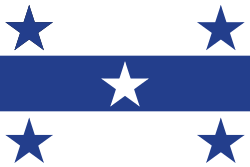Flag of French Polynesia
You can help expand this article with text translated from the corresponding article in French. Click [show] for important translation instructions.
|
 Flag of French Polynesia | |
| Use | Civil and state flag |
|---|---|
| Proportion | 2:3 |
| Adopted | 23 November 1984 |
| Design | Two red horizontal bands encase a wide white band in a 1:2:1 ratio, with the Coat of arms centred on the white stripe |
| Le Tricolore | |
 | |
| Use | National flag, civil and state ensign |
| Proportion | 2:3 |
| Adopted | 15 February 1794 |


The flag of French Polynesia was adopted in 1984.[1] According to the articles of adoption, the flag of French Polynesia must be displayed with the French tricolor, and may be displayed with the flags of the component archipelagos. The French Polynesian flag must be displayed to the left of the French flag, and the flag of the archipelago must be displayed to its right.[2]
Description
[edit]Two red horizontal bands encase a wide white band in a 1:2:1 ratio; centered on the white band is the emblem of French Polynesia as a 0.43m diameter disk with a blue and white wave pattern depicting the sea on the lower half and a gold and white ray pattern depicting the sun on the upper half; a Polynesian canoe rides on the wave pattern; the canoe has a crew of five represented by five stars that symbolize the five island groups;[3] red and white are traditional Polynesian colors.
Flags of component archipelagos
[edit]-
Flag of the Leeward Islands
-
Sports Flag of the Leeward Islands
-
Flag of the Tuamotu Archipelago
Flags of the Society Islands
[edit]Leeward Islands
[edit]Windward Islands
[edit]-
Flag of Tahiti
-
Flag of Moorea-Maiao
Flags of the Tuamotu Archipelago
[edit]Flags of the Austral Islands
[edit]See also
[edit]References
[edit]- ^ "Délibération n° 84-1030 AT du 23 novembre 1984 portant approbation du drapeau et des armes de la Polynésie française". lexpol.pf.
- ^ "Arrêté n° 1196 CM du 4 décembre 1985 réglementant l'apposition et l'exposition de drapeaux, pavillons et emblèmes le long des voies publiques et sur les bâtiments administratifs, édifices et monuments de service public". emblemes.free.fr. Retrieved 1 January 2023.
- ^ "The Flag of French Polynesia". flagdb.com. Retrieved 9 May 2024.
External links
[edit]![]() Media related to Flags of French Polynesia at Wikimedia Commons
Media related to Flags of French Polynesia at Wikimedia Commons



















